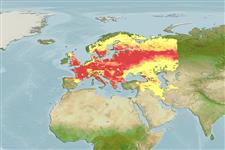Classification / Names
Common names from other countries
Issue
Leuciscus orientalis Nordmann, 1840 is considered valid in Eschmeyer (CofF ver. May 2011: Ref. 86870). This is allocated to Squalius in Ref. 84537, a valid name, but secondary homonym Squalius orientalis Heckel, 1847 needs a replacement name.
Main reference
Size / Weight / Age
Max length : 60.0 cm SL male/unsexed; (Ref. 59043); common length : 30.0 cm TL male/unsexed; (Ref. 556); max. published weight: 8.0 kg (Ref. 2196); max. reported age: 22 years (Ref. 41616)
Length at first maturity
Lm ?, range 7 - 30 cm
Environment
Freshwater; brackish; benthopelagic; pH range: 6.0 - 7.8; dH range: 8 - 25; potamodromous (Ref. 51243); depth range 0 - ? m
Climate / Range
Temperate; 4°C - 20°C (Ref. 2059), preferred ?; 64°N - 35°N, 10°W - 60°E
Distribution
Eurasia: North, Baltic, northern Black, White, Barents and Caspian Sea basins, Atlatinc basins southward to Adour drainages (France), Great Britain north to 56°C, Scandinavia: southern Finland, Sweden north to abut Stockholm. Mediterranean basin from Var to Hérault (possibly Aude) (France) drainages. Introduced elsewhere, Naturally absent from Italy and Adriatic basin.
Countries | FAO areas | Ecosystems | Occurrences | Introductions
Short description
Dorsal
spines
(total): 3;
Dorsal
soft rays
(total): 7-9;
Anal
spines: 3;
Anal
soft rays: 7 - 10;
Vertebrae: 42 - 48. Differs from its congeners in France, North, Baltic, Arctic, Black and Caspian Sea basins by the possession of the following characters: dorsal profile with a well-marked discontinuity between head and trunk; a row of black pigments along free margin of each flank scale, forming a regular reticulate pattern, with no or very few pigments on central part of scales; anal and pelvic fins orange to red; dorsal fin with 8½ branched rays; anal fin with 8½ branched rays (rarely 9½); scales on lateral line 40-45 + 2-3; mouth terminal, with well marked chin; lower jaw tip not included in the upper lip; interorbital distance 37-42% HL; postorbital distance 47-51% HL; eye diameter 17-22% HL, 1.5-2.3 times in snout length; body depth 22-27% SL; lower jaw long, length greater than depth of operculum; iris whitish; pharyngeal teeth 2,5-5,2; in stretched anal fin of individuals larger than about 15 cm SL, distance between tips of first and last branched rays usually greater than caudal peduncle depth (Ref. 59043). Caudal fin with 19 rays (Ref. 2196).
IUCN Red List Status (Ref. 115185)
Threat to humans
Harmless
Human uses
Fisheries: minor commercial; gamefish: yes
Tools
Special reports
Download XML
Internet sources
Estimates of some properties based on models
Phylogenetic diversity index
PD50 = 0.5000 many relatives (e.g. carps) 0.5 - 2.0 few relatives (e.g. lungfishes)
Trophic Level
2.7 ±0.1 se; Based on diet studies.
Resilience
Medium, minimum population doubling time 1.4 - 4.4 years (K=0.12-0.28; tm=3-7; tmax=10; Fec=20,000)
Vulnerability
Moderate vulnerability (44 of 100)
Price category
